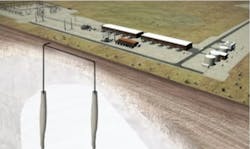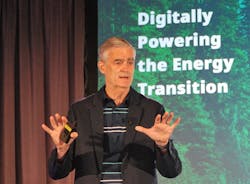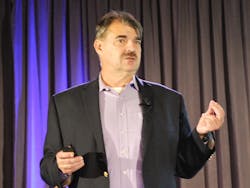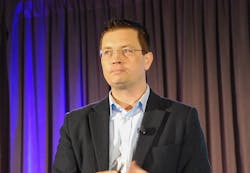Making the Digital Positive Investment now to reduce Costs and Carbon down the road
Spend now or pay much more later in money, sweat and regret.
The concept of preemptive investment is nothing new and has been applied from everything to car maintenance and missing stock market swings.
The credo, however, has taking on a powerful currency of late when it comes to questions surrounding capital expenditures for digitalization and environmental upgrades.
The world’s companies must halve their greenhouse gas emissions every decade onward to achieve Paris Accord goals seeking to reach net zero goals, or more tangibly, slow temperature rise across the globe to avoid greater weather catastrophes.
And the energy sector should lead that intense drive to generate more and pollute less.
“The traditional energy system was built more than a century ago; it needs to go through change,” Emerson Chief Sustainability Officer Mike Train said during the session streamed live and on the internet. “Companies need to have significant investments going forward. . .
The International Energy Agency has estimated that it may take $5 trillion or more –just in Europe alone—in investment to both embrace and employ zero-carbon energy resources and also utilize efficiencies via digitalization, automation and control technologies. The Biden Administration’s Inflation Reduction Act offers more than $300 million but conceivably it’s only a drop in the bucket for what America and world require to reverse heating of the globe.
“Companies need to make significant investments going forward,” Train said at the Emerson Exchange event. “Any way you want to slice this (it’s tremendously expensive). It’ll be exciting, but the world has a lot of work to do.”
Four Stories, united by Digital Commitment
The crowd at the Gaylord Texas in Grapevine then heard from four progressive companies which are partnering with Emerson and also taking their own very distinct paths to decarbonization across a variety of industries—including recycling, power generation and manufacturing.
California-based Origin Materials is moving forward with a business plan to create platform materials such as plastics and fibers used in the textile industry. Origin’s manufacturing facility, planned to be completed in coming years in Louisiana, will use biowaste feedstocks, such as wood residues, to create those products in what the company calls a “carbon negative” impact.
Starting up something new and radically decarbonized is mind-boggling in logistical and fiscal scope. Origin Materials is embracing digitalization and newer forms of data analysis and actionability such as artificial intelligence, to help it smooth that path.
“This journey will take a number of years,” Roman Wolf, vice president of engineering at the company, admitted. “We want to jump ahead of the line. We want plants to run cleaner now.”
Automation, including the partnership with Emerson, is the key driver of those efficiencies and predictive tools, Wolf noted.
“We believe that digital automation is the strategic lever for growth,” he said. “Operational excellence allows you to have more aggressive targets.”
Aggressive might be fair description of the steep path which plastics recycling startup PureCycle Technologies lays ahead for itself. The company was formed to deploy a technology first developed at Proctor and Gamble in 2012, and now wants to upscale that globally before the end of the decade.
PureCycle’s first plant is under construction in Ohio and due to be commercially operational next year, with another planned for South Korea by 2025. The company process is centered on the idea that plastics can be a “renewable” resource transforming waste into reusable pellets to create a “truly circular solution,” company CEO Dustin Olson said at the Emerson Exchange event.
“We believe plastic is good,” Olson pointed out. “The problem with plastic is not plastic itself. The problem with plastic is we don’t recycle it.”
Currently recycling efforts are also environmentally messy and only account for about 5 percent of the product waste put into trash bins. PureCycle argues that it’s non-chemical process of melting, filtering, mixing, purifying, separating, and pelletizing—to oversimplify it—will leave behind a clear white product which reduces carbon emissions 35 percent below current methods and uses 79 percent less energy.
“Our moto is 'born digital,'” Olson said. “What that means is we’re fully committed to a digital foundation upon which we can build everything we do.”
Digitalization leads to better scaling, predictive maintenance, process automation and engineering, he added.
And yes it increases costs to do it this way. But, remember the pay now or pay later adage at the beginning?
“We have the foresight to do it on the front end, so we don’t have to do it on the back end,” the PureCycle CEO told the Emerson crowd.
Underground approach to Decarbonization
The Wednesday morning Exchange presentation took a turn for the more power generational when Mike Drucker, senior vice president head of hydrogen infrastructure at Mitsubishi Power, outlined his company’s hugely ambitious H2 storage project in Delta, Utah.
The Advanced Clean Energy Storage Hydrogen Hub, in which Mitsubishi is partnering with Magnum Development, comprises two enormous below-ground salt caverns. Those giant caves together can theoretically store 300 GWh equivalency of hydrogen available to help decarbonize power generation and transportation via fuel cell infrastructure for heavy-duty trucking.
Earlier this year, Mitsubishi selected Emerson to handle automation of the ACES Delta facility, currently under construction (rendering at top of story).
EnergyTech White Paper from InfoGrid: Energy Management and the Workplace of the Future
Under the Utah plan, renewable energy resources would be utilized to power electrolyzers which take water and separate the hydrogen and oxygen from it. Hydrogen does not contain a carbon atom and thus can help mix with methane natural gas to reduce CO2 emissions from power plant turbine activity.
The Emerson Exchange event also heard about Braskem Idesa Mexico, a joint venture also focused around more environmentally responsible ways to both produce and reuse plastic.
-- -- --
(Rod Walton, senior editor for EnergyTech, is a 14-year veteran of covering the energy industry both as a newspaper and trade journalist. He can be reached at [email protected]).
Follow us on Twitter @EnergyTechNews_ and @rodwaltonelp and on LinkedIn
About the Author
Rod Walton, EnergyTech Managing Editor
Managing Editor
For EnergyTech editorial inquiries, please contact Managing Editor Rod Walton at [email protected].
Rod Walton has spent 17 years covering the energy industry as a newspaper and trade journalist. He formerly was energy writer and business editor at the Tulsa World. Later, he spent six years covering the electricity power sector for Pennwell and Clarion Events. He joined Endeavor and EnergyTech in November 2021.
Walton earned his Bachelors degree in journalism from the University of Oklahoma. His career stops include the Moore American, Bartlesville Examiner-Enterprise, Wagoner Tribune and Tulsa World.
EnergyTech is focused on the mission critical and large-scale energy users and their sustainability and resiliency goals. These include the commercial and industrial sectors, as well as the military, universities, data centers and microgrids. The C&I sectors together account for close to 30 percent of greenhouse gas emissions in the U.S.
He was named Managing Editor for Microgrid Knowledge and EnergyTech starting July 1, 2023
Many large-scale energy users such as Fortune 500 companies, and mission-critical users such as military bases, universities, healthcare facilities, public safety and data centers, shifting their energy priorities to reach net-zero carbon goals within the coming decades. These include plans for renewable energy power purchase agreements, but also on-site resiliency projects such as microgrids, combined heat and power, rooftop solar, energy storage, digitalization and building efficiency upgrades.




